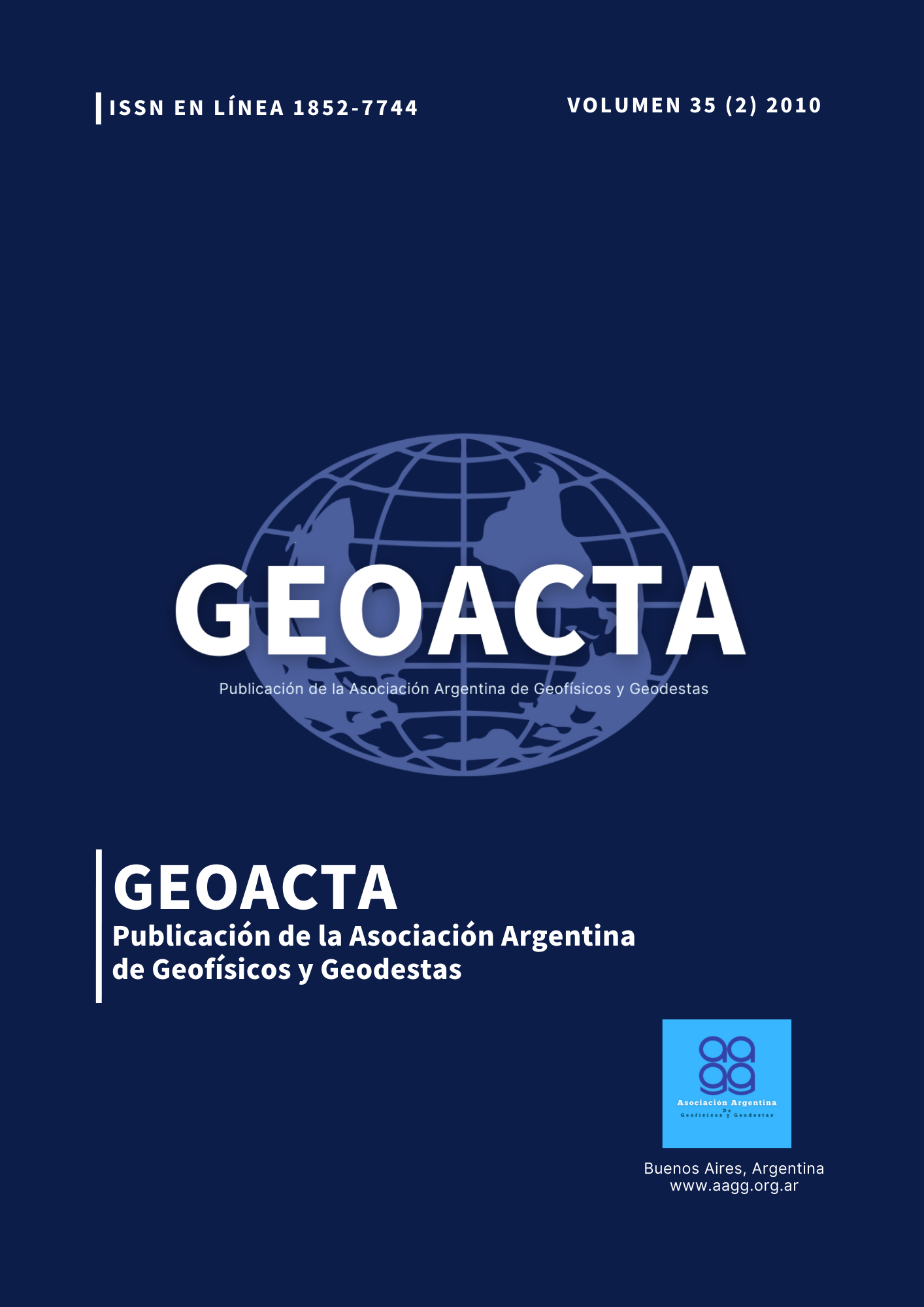Interpolación gravimétrica para el cálculo de los números geopotenciales de la red altimétrica de Argentina en zonas de alta montaña
Palabras clave:
Números geopotenciales, Interpolación gravimétrica, Referencia vertical, Redes altimétricasResumen
Se torna necesario compatibilizar los requerimientos de precisión en las determinaciones altimétricas, con la información disponible y las posibilidades que brinda el instrumental moderno. Para dar solución a este “problema altimétrico” en la Argentina, se debe materializar un nuevo sistema de referencia vertical. El primer paso fundamental será completar el cálculo de los números geopotenciales de los puntos de la red altimétrica nacional. Este cálculo supone, en teoría, el conocimiento del valor medio de la gravedad entre dicho punto y el geoide. En la práctica el problema se simplifica asumiendo una variación lineal entre la gravedad sobre el geoide y la gravedad sobre el punto en cuestión, adoptándose la media aritmética entre ambos valores gravimétricos.
La red altimétrica de Argentina no cuenta con valores de gravedad en todos sus puntos, lo que torna imposible el ajuste final de la red. Para dar solución a este problema y atendiendo a la poco factible posibilidad de realizar campañas de medición gravimétrica en el corto plazo, la alternativa viable es resolver la cuestión mediante la asignación de valores de gravedad a los puntos referidos anteriormente mediante procedimientos matemáticos. La gran extensión territorial del país sumada a su amplio rango de altitudes y a la heterogénea distribución de datos gravimétricos, requiere de un delicado análisis de diversas situaciones posibles. En este trabajo se analiza la problemática en zonas montañosas a través del estudio del comportamiento de diversos tipos de respuestas gravitacionales (gravedad observada, anomalía de aire libre y anomalía de bouger) ante la aplicación de diversos métodos de interpolación.
Descargas
Citas
Brunini, C., G.Font, F.Galbán, E.Lauría, M.C.Pacino, R.Rodríguez, 2001. The Vertical Reference System in the Argentine Republic. Actas Symposium IAG.237-242.
Burrough,P.A., R.A.McDonnell, 1998. Principles of Geographical Information Systems. Oxford Univ. Press. New York, U.S.A.
D’Onofrio, E., M.Fiore, F.Mayer, R.Perdomo, R.Ramos, 1999. La referencia vertical. Contribuciones a la Geodesia en la Argentina de fines del siglo XX. Edit.UNR. Argentina.101-130.
Hofmann Wellenhof B.,H. Moritz, 2005. Physical Geodesy. Springer Wien New York. pp 412.
Isaaks E.H., R.M. Srivastava, 1989. Applied Geostatistics. Oxford University Press. New York. pp 561.
Lauría E., 2006. Hacia un nuevo marco de referencia. Revista Cartográfica, 82:115-136.
Meyer, T.H., D.R.Roman, D.B.Zilkoski, 2004. What Does Height Really Mean? Part I: Introduction. Surveying and Land Information Science. 64(4):223-234.
Meyer, T.H., D.R.Roman, D.B.Zilkoski, 2005. What Does Height Really Mean? Part II: Physics and Gravity. Surveying and Land Information Science. 65(1):5-15.
Meyer, T.H., D.R.Roman, D.B.Zilkoski, 2006. What Does Height Really Mean? Part III: Height Systems. Surveying and Land Information Science. 66(2):149–160.
Meyer, T.H., D.R.Roman, D.B.Zilkoski, 2006. What Does Height Really Mean? Part IV:GPS Orthometric Heighting. Surveying and Land Information Science. 66(3):165–183.
Meyer, T.H., 2004. The discontinuous Nature of Kriging Interpolation for Digital Terrain Modeling. Cartography and Geographic Information Science. 31(4):209-216.
Pacino, M. C., E.A.Lauría, J.D.Fairhead, D.Blitzkow, 2006. New Gravity Anomaly Maps for Argentina. MAGARG. En prensa en Revista Geofísica Internacional.
Pacino, M. C., 2005. Absolute Gravity Measurements and Gravity Networks in South America. Dynamic Planet 2005 (Elsevier Ed.). En prensa.
Pacino, M. C., D. Del Cogliano, G. Font, J. Moirano, P. Natalí, E. Lauría, R.Ramos, S. Miranda, 2005. Activities Related to the Materialization of a New Vertical System for Argentina. Dynamic Planet IAG Symposium. Springer-Verlag. 671-676.
Sullivan, J., 1998. Curso de Geoestadística para Mineria II. Gerencia de Planificación y Tecnología Minera. Chile. pp 54.
Sullivan, J., 1998. Curso de Geoestadística para Mineria III. Gerencia de Planificación y Tecnología Minera. Chile. pp 59.
Wood, J., P.Fisher, 1993. Assessing Interpolation Accuracy in Elevation Models. IEEE Computer Graphics and Applications. 13(29):48-56.
Descargas
Publicado
Cómo citar
Número
Sección
Licencia
Derechos de autor 2010 Juan Carlos Villella, María Cristina Pacino

Esta obra está bajo una licencia internacional Creative Commons Atribución-NoComercial-CompartirIgual 4.0.
A partir de 2022 (Vol. 43 número 2) los artículos se publicarán en la revista bajo una licencia Creative Commons Atribución- NoComercial-CompartirIgual 4.0 Internacional (CC BY-NC-SA 4.0)
Acorde a estos términos, el material se puede compartir (copiar y redistribuir en cualquier medio o formato) y adaptar (remezclar, transformar y crear a partir del material otra obra), siempre que a) se cite la autoría y la fuente original de su publicación (revista y URL de la obra), b) no se use para fines comerciales y c) se mantengan los mismos términos de la licencia.
Previo a esta fecha los artículos se publicaron en la revista bajo una licencia Creative Commons Atribución (CC BY)
En ambos casos, la aceptación de los originales por parte de la revista implica la cesión no exclusiva de los derechos patrimoniales de los/as autores/as en favor del editor, quien permite la reutilización, luego de su edición (posprint), bajo la licencia que corresponda según la edición.
Tal cesión supone, por un lado, que luego de su edición (posprint) en Revista GEOACTA de la Asociación de Geofísicos y Geodestas las/os autoras/es pueden publicar su trabajo en cualquier idioma, medio y formato (en tales casos, se solicita que se consigne que el material fue publicado originalmente en esta revista); por otro, la autorización de los/as autores/as para que el trabajo sea cosechado por SEDICI, el repositorio institucional de la Universidad Nacional de La Plata, y sea difundido en las bases de datos que el equipo editorial considere adecuadas para incrementar la visibilidad de la publicación y de sus autores/as.
Asimismo, la revista incentiva a las/os autoras/es para que luego de su publicación en Revista de la Asociación de Geofísicos y Geodestas depositen sus producciones en otros repositorios institucionales y temáticos, bajo el principio de que ofrecer a la sociedad la producción científica y académica sin restricciones contribuye a un mayor intercambio del conocimiento global.












